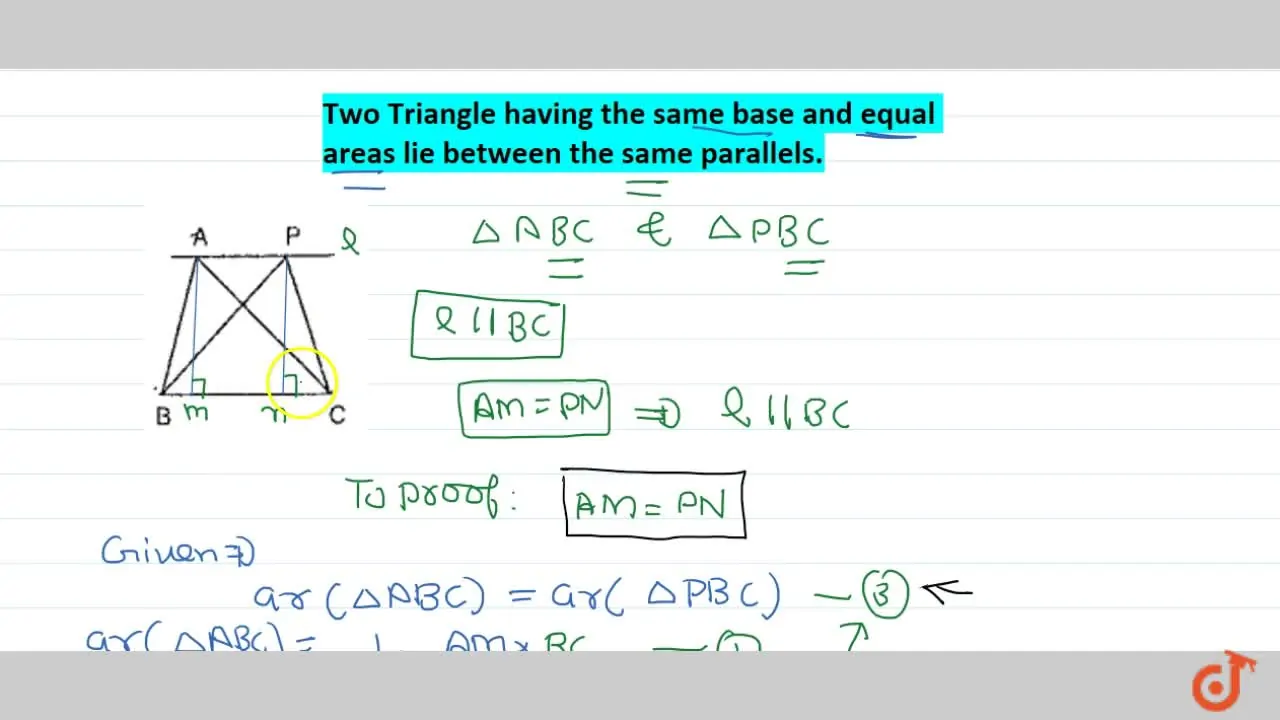Two Trinangle having the same base and equal areas lie between the same parallels.
Given: Two △ABC and △PBC on the same base BC and between the same parallel lines BC and AP.
To prove: ar(ΔABC)=ar(ΔPBC)
Construction: Through B, draw BD parallel to CA intersecting PA produced in D and through C, draw CQ parallel to BP, intersecting line AP in Q.
Proof:
We have, BD parallel CA [By construction]
And, BC parallel DA [Given]
∴Quadrilateral BCAD is a parallelogram.
Similarly, Quadrilateral BCQP is a parallelogram.
Now, parallelogram BCQP and BCAD are on the same base BC, and between the same parallels.
∴ar(BCQP)=ar(BCAD) ....(i)
We know that the diagonals of a parallelogram divides it into two triangles of equal area.
∴ar(ΔPBC)=12ar(BCQP) ....(ii)
And,
ar(ΔABC)=12ar(BCAD) ....(iii)
Now,
ar(BCQP)=ar(BCAD) [From (i)]
⇒12ar(BCAD)=12ar(BCQP)
Hence, ar(ΔABC)=ar(ΔPBC) [Using (ii) and (iii)]
Hence Proved.
Related Playlists
Similar Questions
Theorem 9.3 : Two triangles having the same base (or equal bases) and equal areas lie between the same parallels.
View SolutionTriangles having the same base have equal area. True or false
View SolutionTriangles on the same base and between the same parallel are equal in area.
View SolutionFigures on the same base and between the same parallels
View SolutionIf two triangles are on the same base and between the same parallels. Then find the ratio of area of the two triangles.
View SolutionIf P, R, T are the area of a Parallelogram, a rhombus and a triangle standing on the same base and between the same parallels, which of the following is true ?
View SolutionIf P,R,T are the area of a parallelogram , a rhombus and a triangle standing on the same base and between the same parallels, which of the following is true ?
View SolutionTriangles on the same base and between the same parallels are equal in area. GIVEN : Two triangles ABC and PBC on the same base BC and between the same parallel lines BC and AP. TO PROVE : ar(ABC)=ar(PBC) CONSTRUCTION : Through B, draw BDCA intersecting PA produced in D and through C, draw CQBP, intersecting line AP in Q.
View SolutionA triangle and a parallelogram are on the same base and between the same parallels. The ratio of the areas of triangle and parallelogram is 1:1 (b) 1:2 (c) 2:1 (d) 1:3
View SolutionIf a triangle and a parallelogram are on the same base and between thesame parallels, then prove that the area of the triangle is equal to half the area of the parallelogram.
View Solution


